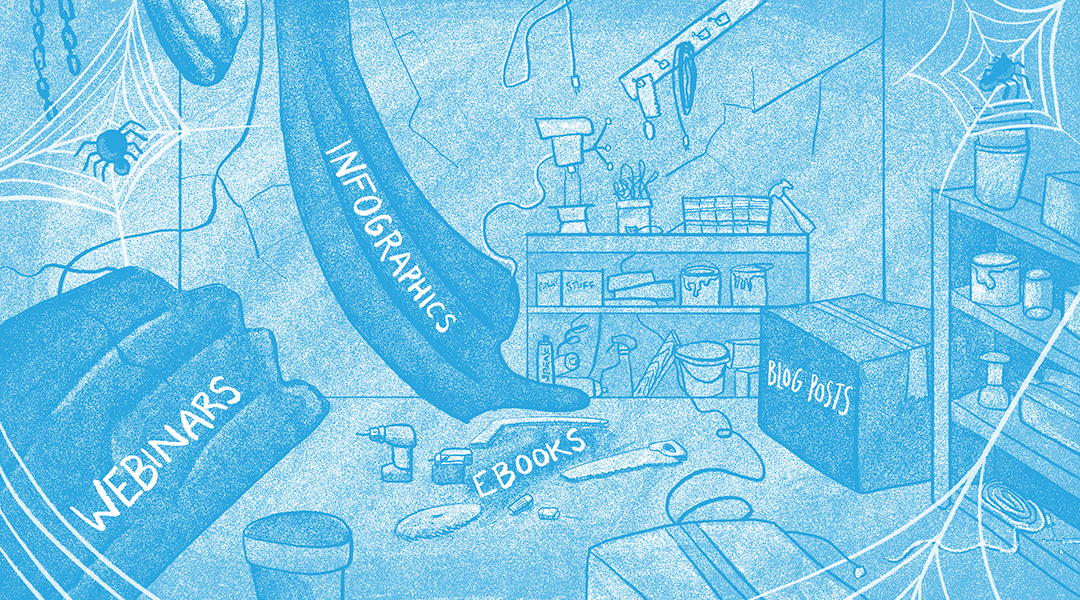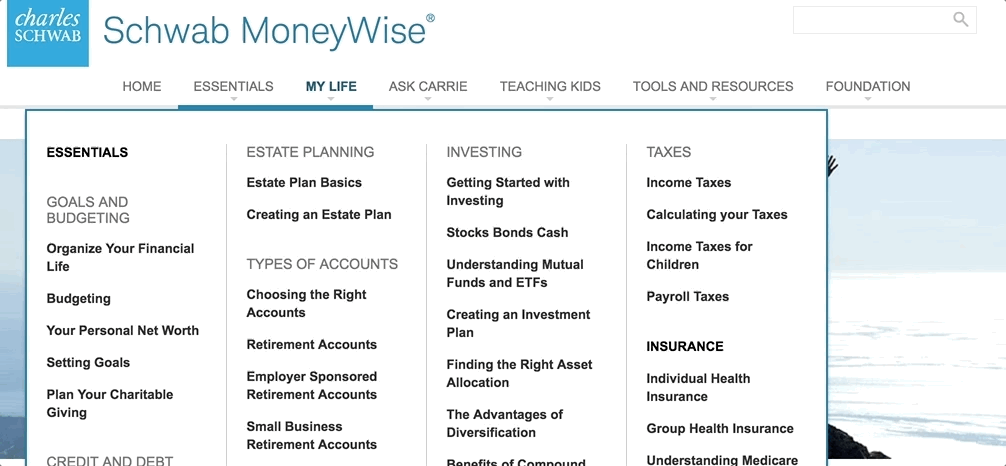If you’ve published a lot of blog posts over the years, updating and organizing your blog is one of the surest ways to improve your traffic. By merging old posts and building internal links, even smaller websites can go toe-to-toe with bigger domains in the SERPs.
Your blog might be in a state of absolute chaos without you even knowing.
Do you feel trapped by your own editorial calendar, with no way out except to continue publishing new content week in and week out?
Does the thought of going through all your old blog posts to organize or optimize them give you hives?
If so, you’re not alone.
Most blogs are in disarray. But the good news is that taming a wild, overgrown blog doesn’t have to be as scary as it sounds.
Most blogs look something like this:

Your blog may feel like a messy, neglected shed: it’s full of useful tools and materials, but you hate going in there. It’s impossible to find anything, and the thought of digging through all the useless, decrepit stuff (not to mention the spiders) to find what you want just doesn’t seem worth it.
That’s a shame because each piece of content on your blog has a job to do—but if your blog is disorganized, your content can’t pull its weight.
But your blog should look more like this:

A good blog, even one with a lot of old content, should be easy for your audience to navigate, easy for your sales and marketing teams to access, and really, really good at bringing in new traffic on its own.
Why should you clean up your blog?
1. To get more organic traffic
Sometimes the key to more traffic is less cluttery content.
For example, Ahrefs, one of our favorite SEO tools, culled about half of their blog content at the end of 2015 (as part of a larger strategy). Three months later, their traffic was up by 89%. They cut another third of their blog content in 2018, and traffic increased by another 7% in two months.
Organizing your blog also gives you a chance to deindex low-engagement pages, which means Google will only see your good stuff. (If your website as a whole gets good engagement, Google tends to send more traffic your way.)
2. To avoid Google penalties
Disorganized blogs are often full of content written before significant Google updates. For example, the way Google treated keyword density and content length in 2011 is very different from how Google treats content now.
This is why having a disorganized blog risks sending negative sitewide signals to Google. If Google sees your site has a bunch of low-quality content, it can have negative implications for your site as a whole.
3. To give your readers a better experience
It’s not uncommon for readers to face a long, cascading list of blog topics and categories. (For example, look at how Charles Schwab handles this!)

Disorganized blogs are difficult to navigate. (If you have a hard time finding your way around your own blog, imagine how the reader feels.) No matter where the reader turns, they’re confronted with a pile of old content that they need to sort through in order to find something useful.
Plus, disorganized blogs are full of articles that cover the same topics in very similar ways—which results in a good deal of redundant content. This often happens when responsibility for the blog shifts from employee to employee over the years. It’s easy for a new editor to write or commission content that covers the same ground as previous posts.
Not only does this invite confusion (and contradiction), it’s also a huge waste of your time. Which brings us to the fourth big reason you should clean up your blog …
4. To get off that content treadmill
For years, content marketers were told to publish new blog posts on a consistent basis. Website visitors became leads, and leads were automatically notified when a new blog post went live. Every time you published a new post, you had a spike of traffic to your website.

Business blogs were a lot like publications—they were supposed to go out on a certain schedule to keep the audience engaged.
But as audiences grew, so did the pressure to keep the blog posts coming.

And this is how many blogs got into the state of chaos they’re in today. Years of meeting publishing quotas got content teams to a point where they spent all their time making content, and never really promoted it outside of that one RSS email.
You don’t want to stop publishing content—what if your audience loses interest? So you keep toiling away on blog post after blog post. But at the same time, you’ve accumulated hundreds of posts that you never truly use.
And because people only receive notifications about your new blog posts, that means every old post, no matter how valuable it is, gets the shaft.
Which means most of your content is unread by most of your audience … but you’re still strapped to that content treadmill.

This might be where you are now. You have a mountain of content—more content than you know what to do with. And the idea of slowing production to organize all those old posts?
Terrifying.
But it can be done.
Here’s how.
How to clean up your old blog in 6 steps
Cleaning up your blog isn’t an easy process. You’ll need to dig through your old material, compare your old stuff to the leading content in your industry today, and make some big changes. (Which is a big reason why companies pay us to do this for them!)
Here’s how we do it.

Step 1: Take inventory of your content
Make sure you have an idea of what you’ve published, and where you’ve published it. Although you’re focusing on your blog, you’ll want to expand this step to include all your marketing content: ebooks, your YouTube channel, Quora answers, forums, etc.
You should finish this step with a list of all the content you have.
Step 2: Find the winning content
Odds are there are at least a few pieces of content that have succeeded for you in the past. Use your analytics tools to find which posts are gaining the most organic traffic, which posts are getting the most backlinks, and which posts are getting the most shares on social media.
You’ll also want to note what kinds of content are getting this attention. Pay attention to the topics, the formats, and the characteristics of the content that’s working—you’ll need this for step 5.
Step 3: Find the problem content
There’s a good deal of content that’s not going to survive this process—at least not in its current form. This is the content that you’ll either fix, merge, de-index, or delete altogether.
As you’re going through your content, you’ll want to keep an eye out for two kinds of problem content: posts that are out-of-date, and posts that are low-quality.
Out-of-date posts use old terminology, recommend obsolete tactics, or contradict your current content. This includes posts about time-sensitive promotions and announcements.
Low-quality posts have all kinds of tells. Duplicate or boilerplate-heavy content, pages with high bounce rates, and posts with low on-page times fall into this category.
Take note of these posts, and hold on to them loosely.
Step 4: Assess the competition
At this point, you’ll have a good idea of what kind of content you’re working with on your own blog. It’s time to see what your new, clean blog is going to have to go up against.
First, analyze your direct competitors. Find out which pages of theirs are winning organic traffic. Discover which pieces of content are getting links. And of course, dig into their PPC campaigns to see which keywords they’re paying to rank for. (Ahrefs is a terrific tool for this.)
Next, analyze the industry blogs and publications in your space. These folks are writing content all the time, and so they’re a good source of keyword inspiration.
Finally, take a spin through the SERPs for some of the keywords these players rank for. Which websites are beating them? What kind of content is winning the organic traffic?
Step 5: Plan, fix, and create
You know what content is working for you. You know what’s working for the other guys. And you know what’s not working for you. Now it’s time to give your blog the makeover it needs.
It’s likely going to involve at least a few of these practices:
- Consolidating categories. Blogs suffer from category creep over time—cleaning up your blog should reign your content back into a workable architecture.
- Creating pillar content. The old way of blogging encouraged quantity over quality. Odds are that you can merge a good deal of old posts together to make standalone beginners’ guides on the topics you blog about.
- Internal link building. Seek out opportunities to link your blog posts to each other—especially when it comes to building internal links to pillar content.
- Beefing up thin content.
- Updating antiquated content with current vocabulary, recommendations, and stats.
- Retiring content that’s no longer useful.
- Adding relevant calls to action to old posts.
Step 6: Automate distribution
Once your old blog’s cleaned up, there’s one more task you need to do: make sure that the content is automatically distributed to your audience as it grows. This gets you off that content treadmill and allows you to focus your content creation energy on quality, not quantity.
A few smart ways to automate distribution include:
- Creating automated email campaigns to nurture leads. When someone downloads an ebook, don’t just hound them about setting up a conversation with sales. Instead, stagger your pitches with emails highlighting helpful content from your blog. This keeps your leads engaged, and builds your brand authority with them until they’re ready to hop on a call.
- Use content in retargeting ads to pull people back to your website. It’s a smart way to engage people who found your site but haven’t even joined your email list yet.
- Run your content to lookalike audiences. Let your content make a first impression on people who are similar to your existing website visitors, app users, and Facebook fans—create a lookalike audience and promote your content to them!
Blog strategically, friends
Cleaning up an old blog is a harrowing, scary process. But doing it will bring in more traffic, give your readers a better experience, and give you a much better grip on your content marketing efforts.
It’s tough. But it’s worth it.


